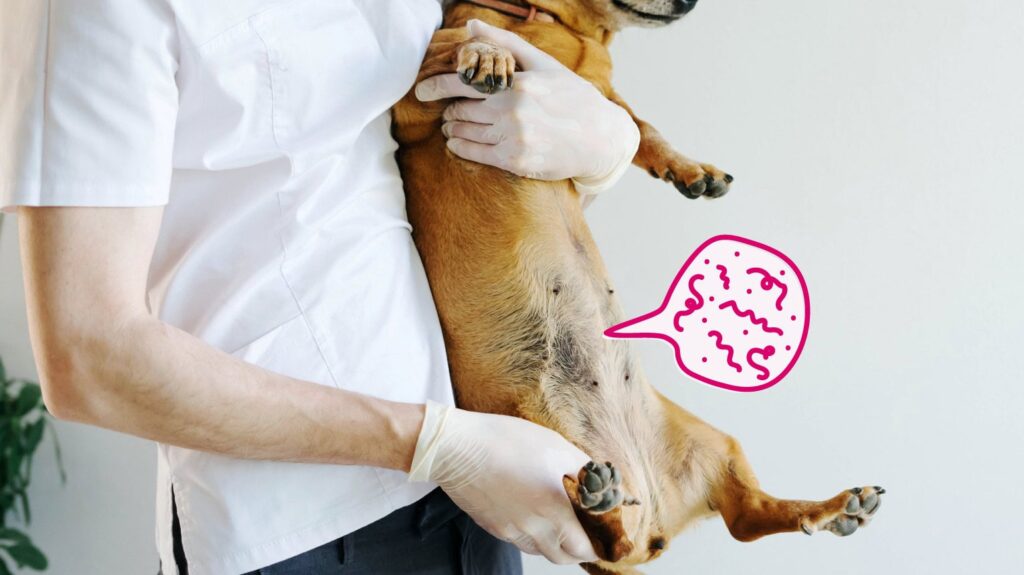Nausea in dogs is a common condition that makes your pet feel sick, uneasy, and sometimes causes vomiting. It happens when the stomach becomes upset due to things like eating spoiled food, sudden diet changes, or underlying health problems. Dogs experiencing nausea may drool, lick their lips, or refuse food. While mild cases go away on their own, frequent or severe nausea can signal deeper issues that need a veterinarian’s attention.
1. What Is Nausea in Dogs?
Nausea in dogs means your pet feels sick to its stomach, just like humans do when they want to vomit.
It’s not a disease by itself, but a sign of another problem inside the body. Dogs with nausea often lick their lips, drool a lot, or eat grass to make themselves vomit.
Sometimes nausea is mild and goes away quickly, but other times it’s a sign of something serious like infection, poisoning, or digestive trouble. Knowing the early signs of nausea in dogs helps you act fast and get your dog the care it needs.
2. Common Signs and Symptoms
Dogs can’t say they feel sick, so owners must notice the small changes. Here are the most common symptoms of nausea in dogs:
Excessive drooling or foamy saliva
Licking lips or swallowing repeatedly
Eating grass (to induce vomiting)
Loss of appetite or refusal to eat
Vomiting or retching
Restlessness or whining
Yawning or pacing
Lethargy or tiredness
Dehydration (from repeated vomiting)
If your dog shows many of these signs, it’s likely dealing with nausea or stomach upset.
3. Causes of Nausea in Dogs
There are many reasons why dogs experience nausea. Some are harmless, while others are serious and need a vet’s help.
Let’s look at the most common causes:
a. Dietary Indiscretion (Eating Something Bad)
Dogs love to explore with their mouths. Eating spoiled food, garbage, or grass can easily cause nausea in dogs. This is one of the most frequent and usually short-term causes.
b. Sudden Diet Changes
Changing your dog’s food too quickly can upset its stomach. When you switch brands or diets, do it slowly over 7–10 days to prevent nausea and vomiting.
c. Motion Sickness
Just like humans, dogs can get car sick. Puppies are more prone to motion-related nausea, especially during long drives.
d. Infections
Viral or bacterial infections such as parvovirus, leptospirosis, or gastroenteritis can cause severe nausea, vomiting, and diarrhea in dogs.
e. Parasites
Intestinal worms like roundworms or hookworms irritate the stomach and lead to nausea, vomiting, and loss of appetite.
f. Toxins or Poisons
Household chemicals, chocolate, grapes, medications, and plants like lilies are toxic to dogs. Poisoning often causes sudden nausea in dogs followed by vomiting.
g. Organ Problems
Diseases of the liver, kidneys, or pancreas (like pancreatitis) are major causes of long-term nausea.
h. Anxiety or Stress
Emotional distress, fear, or nervousness can also cause upset stomachs and dog nausea, even without food problems.
i. Cancer or Tumors
Cancers of the digestive system may trigger chronic nausea and vomiting. Older dogs are more at risk.
4. How Veterinarians Diagnose Nausea in Dogs
If nausea lasts more than 24 hours or your dog vomits repeatedly, see a vet immediately. To find out what’s wrong, the vet may perform:
Physical exam: Checking the stomach, gums, and hydration
Blood tests: To check liver, kidney, and pancreas function
Urine test: For signs of infection or toxins
X-rays or ultrasound: To detect blockages, tumors, or foreign objects
Fecal exam: To look for worms or parasites
Sometimes, the vet might also test for specific diseases like parvovirus or pancreatitis, depending on symptoms.
5. Treatment for Nausea in Dogs
Treatment depends on what’s causing the problem. Here are common approaches vets use:
a. Fasting and Hydration
The vet may advise not to feed your dog for 12–24 hours to rest the stomach. Small sips of water or oral rehydration solutions keep your pet hydrated.
b. Medications
Antiemetics (anti-nausea drugs): Such as Cerenia (maropitant) or ondansetron help reduce nausea and vomiting.
Antacids: Like famotidine or omeprazole lower stomach acid.
Antibiotics: If the nausea comes from infection.
IV fluids: In severe cases, to correct dehydration.
c. Dietary Management
After the fasting period, reintroduce food slowly with bland meals like:
Boiled chicken and white rice
Plain boiled potatoes
Low-fat cottage cheese
Avoid oily, salty, or spicy foods. Feed small portions several times a day until your dog’s stomach settles.
d. Treating Underlying Diseases
If nausea is due to kidney disease, liver failure, or pancreatitis, long-term management with medication and diet is needed.
For example:
Dogs with kidney issues may need low-protein diets.
Liver patients may require special supplements.
Your vet will tailor a plan depending on the diagnosis.
6. Home Remedies and Care Tips
While medical help is important, mild cases of nausea in dogs can often be managed at home. Here’s what you can do safely:
Keep your dog hydrated. Offer small sips of water every 30–60 minutes.
Let your dog rest. Avoid play or walks during recovery.
Feed plain food. Bland meals are gentle on the stomach.
Avoid rich treats or table scraps.
Monitor vomiting frequency. If it continues for more than 24 hours, see a vet.
Keep toxins away. Lock up cleaning agents and human food that can harm pets.
If your dog shows serious symptoms like blood in vomit, collapse, or severe dehydration, do not delay veterinary care.
7. How to Prevent Nausea in Dogs
Prevention is better than cure! Here are simple ways to reduce the risk of nausea:
Stick to one diet — avoid changing food suddenly.
Feed at regular times.
Keep garbage and spoiled food out of reach.
Use deworming medicine regularly (every 3 months).
Avoid giving human food or medication unless your vet says so.
Use a seatbelt harness for car rides to prevent motion sickness.
Schedule annual checkups to detect early health issues.
A healthy lifestyle is the best defense against nausea in dogs.
8. When to See a Vet Immediately
Some cases of nausea are mild, but others can be life-threatening. Take your dog to a vet right away if you notice:
Vomiting for more than 24 hours
Blood in vomit or stool
Extreme tiredness or collapse
Refusal to eat or drink
Signs of pain or bloated belly
Persistent drooling and gagging
These may point to serious diseases like parvovirus, pancreatitis, or intestinal blockage that need emergency treatment.
9. Long-Term Effects of Chronic Nausea
If untreated, chronic nausea in dogs can lead to:
Weight loss
Dehydration
Electrolyte imbalance
Organ failure (if underlying disease worsens)
Behavioral issues from constant discomfort
That’s why early attention is so important — long-term nausea is often a symptom of something deeper.
10. Natural and Holistic Approaches
For mild cases, some natural remedies can soothe the stomach, but always ask your vet first.
Safe Natural Options:
Ginger tea (in small doses): Helps calm nausea naturally.
Pumpkin puree: Gentle fiber that supports digestion.
Probiotics: Maintain gut balance and prevent upset stomachs.
Chamomile tea: Reduces gas and calms the stomach.
⚠️ Important: Never give herbs or home treatments without checking with your vet, as some can be toxic for dogs.
11. Caring for Puppies with Nausea
Puppies have delicate stomachs and dehydrate quickly. If your puppy vomits more than twice or won’t eat for 12 hours, call a vet. Puppies are at high risk for parvovirus, which starts with severe nausea and vomiting.
Keep the puppy:
Warm and hydrated
Away from unvaccinated dogs
On a vet-recommended diet
Early care can save a young dog’s life.
12. Senior Dogs and Nausea
Older dogs often have nausea due to aging organs, slower digestion, or long-term medication. You can help by:
Feeding smaller, more frequent meals
Ensuring easy-to-digest food
Scheduling vet visits every 6 months
Checking for early signs of liver or kidney trouble
Nausea in older dogs is often manageable with the right diet and routine care.
13. Psychological Causes
Sometimes, nausea in dogs can come from anxiety or emotional distress.
For example, a dog might feel sick before car rides, vet visits, or thunderstorms.
Tips to help:
Use calming sprays or pheromone diffusers
Create a quiet, safe space
Practice slow desensitization to triggers
Reward calm behavior
When emotional issues cause stomach upset, both behavioral and medical care may be needed.
FAQs About Nausea in Dogs
Q1: What can I give my dog for nausea at home?
Only give vet-approved medicines like Cerenia or Pepcid. Never give human meds like Pepto-Bismol or ibuprofen — they can be toxic.
Q2: Can nausea in dogs go away on its own?
Yes, if it’s caused by mild indigestion. But if it lasts over a day, get a vet checkup.
Q3: Can dogs get nausea from stress?
Yes, stress and anxiety are known to cause nausea in sensitive dogs.
Q4: How can I tell if my dog feels nauseous?
Lip licking, drooling, and eating grass are common early signs.
Q5: Is vomiting the same as nausea?
Not always. Nausea comes first — vomiting is often the result of it.
Conclusion
Nausea in dogs is a common but important symptom that should never be ignored. Whether it’s caused by spoiled food, infection, or a more serious disease, quick attention keeps your dog healthy and comfortable.
Always watch for early signs like drooling, loss of appetite, or vomiting. With proper diet, vet care, and love, your dog can recover quickly and live a happy, active life.

